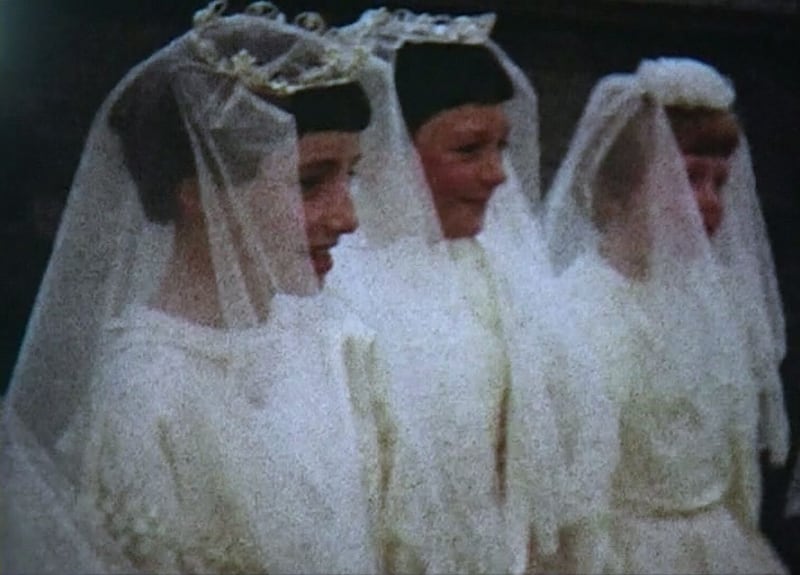It’s an unavoidable fact of human nature that people are attracted to cults. It’s a similarly unavoidable fact of human nature that people are very, very, very attracted to TV programmes about cults.
Such shows have certainly been in vogue in recent years, with about two dozen available on Netflix and Prime Video alone. Even the most well-executed of these – HBO’s The Vow or Netflix’s Wild Wild Country, for example – can’t help occasionally falling into the trap of portraying their victims as feckless freaks and gullible goons.
By contrast, Inside the Cult of the Jesus Army (BBC Two, Sunday) is a more sober and sensitive take on one such sect, the Jesus Fellowship, and it’s all the more fascinating for it.
The show opens with ITV footage from the small village of Bugbrooke, in Northamptonshire in England. It’s the sort of place that, if it did not exist, drama executives would have been forced to invent it. An unspoilt vista of postcard-pretty homes and shops, all cricket matches and church fetes, suddenly interrupted by the abrupt growth of a radical new church – of the shouting, chanting, speaking-in-tongues variety – formed around a charismatic pastor, Noel Stanton.
50 great Irish brands to gift for Christmas, from fashion to food, jewellery to beauty
Nude saunas in Ireland: ‘I realise I will soon be naked among these strangers’
Fine Gael’s ‘new generation’ who quit: ‘Many TDs don’t see it as a career any more’
Paschal Donohoe’s worst sin: being ‘a wee bit scabby on nights out’
Stanton cuts a rather imposing figure. Looking, ironically enough, like an evangelical Richard Dawkins, his manner is stern and austere, his rhetoric full of vehemence and passion. His demands for a militant form of Christianity take purchase, and soon 60 of his most committed congregants surrender their homes and personal wealth to live in one big farmland commune, overseen by a leadership structure with Stanton at its top.
Members cut themselves off from their wider families, withdraw children from school and sell their toys. Adults relinquish jewellery, cosmetics, TV, radio – even reading, hobbies and pets. Still, the influence of Satan is discerned everywhere, exorcisms are routinely performed, and radical prescriptions are placed on adult congregants’ sex lives – namely, a strict culture of celibacy underpinned by Stanton’s confused and angry relationship with his own sexuality; one which gives way to rampant child abuse as the movement picks up members around Britain.
This two-part series, which concludes on Sunday, is feathered through with sessions given by a psychotherapist, Gillie Jenkinson, to former members of Stanton’s congregation. Jenkinson, once a member of a religious cult herself, conducts these sessions with empathy and tact. She gives survivors space to describe their experiences and how, decades later, they still worry that their spirits are unclean, and to explain what led them to stay within a community that exercised extreme social control, communal punishment, and abuse.
It’s a striking, sobering watch, which nimbly conveys how quickly talk of radical love can give way to nightmarish brutality. And it reminds us that those who find themselves in thrall to such cults are not gullible freaks but ordinary, vulnerable individuals, susceptible to the wiles and persuasions of those adept at wielding power and control.
Their stories attain particular resonance when viewed alongside Pray for Our Sinners (RTÉ One, Wednesday), a survey of the stranglehold that Catholic-run institutions had on Ireland for the better part of our recent history.

It, too, begins with a procession of imagery culled from the archives: RTÉ footage showcasing the role the church held in daily life in every part of the country, when Mass attendance topped 90 per cent and mass incarceration was given a variety of other names.
“For much of the 20th century in Ireland,” Sinéad O’Shea, the film’s director, tells us in her narration, “there were more people incarcerated, per capita, than any other place in the world. A person could be institutionalised if they were poor, if they were considered to be living with a mental illness, if they were pregnant and unmarried, if the authorities saw fit.”
To illustrate this, she focuses on her hometown of Navan, and a handful of people who experienced abuses first-hand. We meet Norman, beaten as a boy by the brothers at a local De La Salle school; Betty, who was sent to a mother-and-baby home when she became pregnant as a teen; and Ethna, who resisted entering such a home but still had her child taken from her by religious orders straight after she was born.
All speak, with deeply affecting eloquence, of the unutterable things they suffered but also of the general culture of fear, obedience and silence that pervaded society. “Only crazy people complained,” we are told. “Or Americans.”
Just as importantly, we meet Mary Randles. She, alongside her husband, Paddy, blazed a trail against the power and control of religious orders in Navan, and nationwide, campaigning against corporal punishment, and providing refuge for young mothers seeking to escape the demeaning institutions designed to incarcerate them.
[ ‘It was always the woman, she was the one, she was the sinner’Opens in new window ]
Although the film’s focus is on a few stories within a single town, the true horror might be that a similar survey would likely be possible in any corner of Ireland; the thousands of confirmed sexual-abuse victims uncovered in hundreds of churches and educational institutions; the innumerable everyday examples of physical abuse meted out to children in church-run schools; the tens of thousands of girls imprisoned, beaten and forced to do unpaid work in the Magdalene laundries and mother-and-baby homes.
Within my extended family alone, I’m fairly sure I could put together a similar number of subjects as O’Shea does here. I’ve yet to meet an Irish person who couldn’t say the same.
One temptation when watching this film’s searing testimony, and the artfully curated archive footage featured within, is to consider this a story of sins long past, a cautionary fable from the bad old days of black and white. It’s worth recalling, therefore, that the last Magdalene laundry closed in October 1996. To place, at front of mind, the jarring truth that they were still around to see Boyzone and the Spice Girls top the charts. That this nationwide system of barbarous incarceration outlived Tupac Shakur.
It is a remarkable, important document covering just one localised sliver of this phenomenon, and if it contains elements that anger and disturb – how could it not? – there is just as much courage, dignity and inspiration.
O’Shea’s film A Mother Brings Her Son to Be Shot, from 2017, showed an uncommon knack for capturing small human details. In that documentary she tapped at the shell of poverty and punishment in post-ceasefire Derry, and managed to prise pathos, wonder and even humour from the contents within. Here that knack gives us tender and empathetic testimonies from survivors, but also a deeply human streak of warmth and resolve.
Pray for Our Sinners is a film that will, and should, make viewers angry. At the people who did this to several generations of an entire nation. At the institutions still refusing to acknowledge or compensate those they harmed. And at those in our media who would play down such horrors as mere products of their time, loudly nagging that they be afforded some form of grotesque, and unmerited, nuance.
More than any of that, however, Pray for Our Sinners reminds us that we have cause to be inspired. Both by those speaking up now about what happened to them and by those who spoke up at the time on their behalf. It is for them, if nothing else, that we should all be thanking God.

















